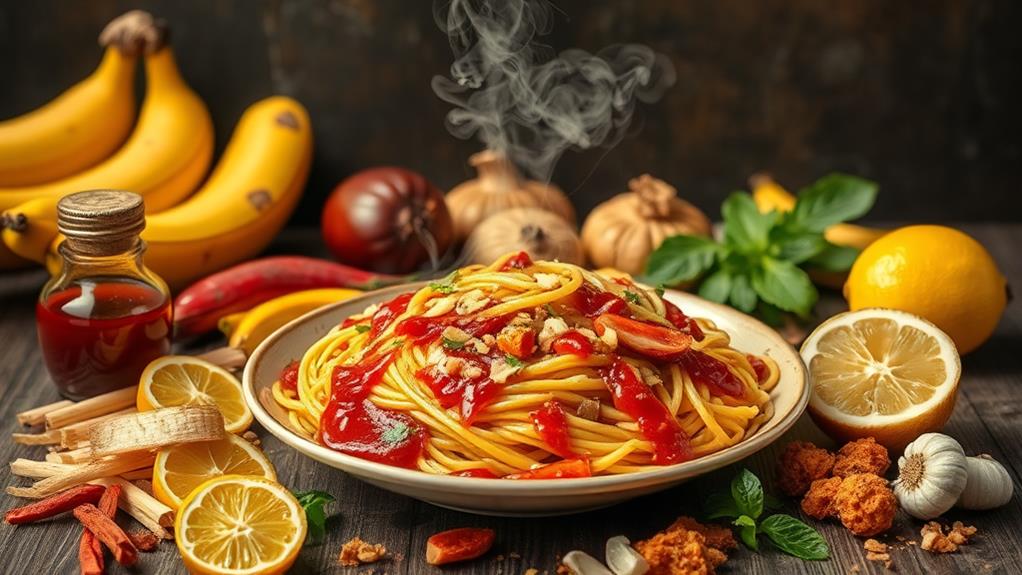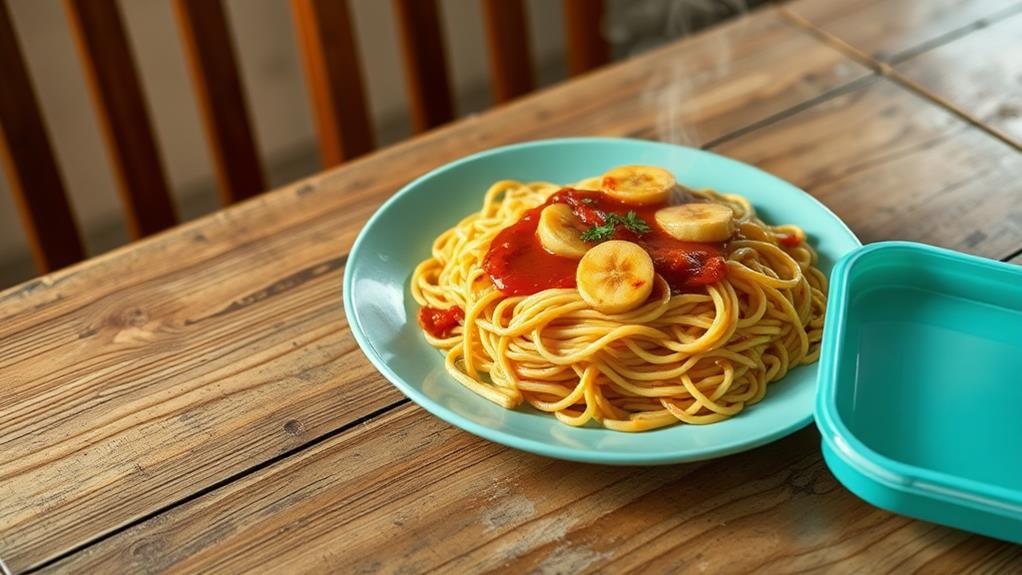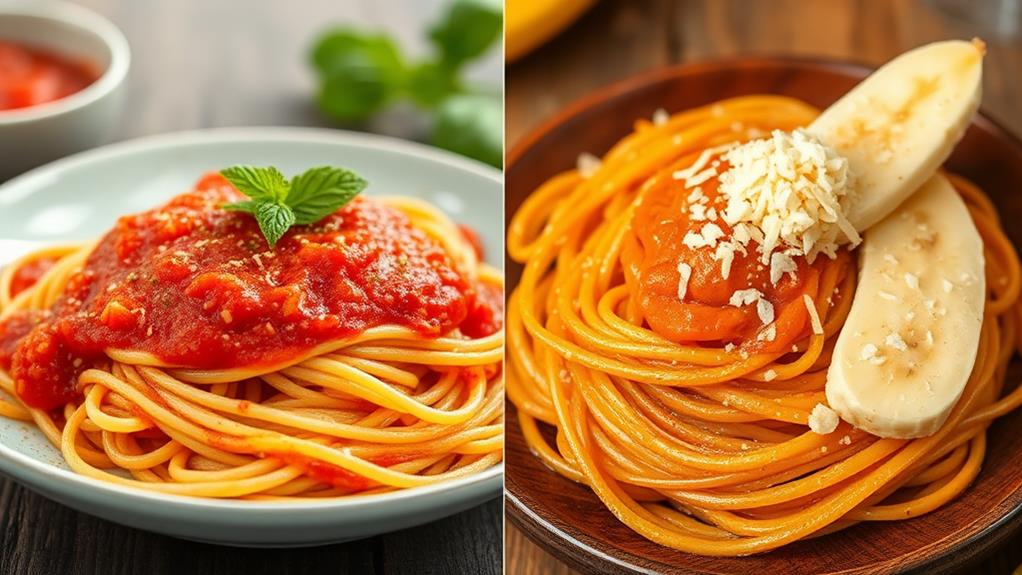Banana ketchup spaghetti is a staple at Filipino gatherings and celebrations because it represents a creative solution to historical challenges.
During the American occupation and World War II, tomato shortages led to the use of banana ketchup as a substitute. This sweet and tangy condiment, made from bananas, vinegar, sugar, and spices, added a unique flavor profile to traditional spaghetti.
This dish is a cultural phenomenon that evokes nostalgia and community.
In Filipino culture, banana ketchup spaghetti symbolizes happiness, long life, and prosperity. Its significance goes beyond being a favorite food; it represents the resourcefulness and adaptability of the Filipino people.
History of Filipino Spaghetti

The American occupation of the Philippines from 1898 to 1946 led to a culinary fusion that introduced new flavors and cooking techniques to the locals. During this period, foreign cuisine, including Italian dishes, was introduced to the Philippines.
One outcome of this cultural exchange was the creation of Filipino spaghetti, a dish distinct from its Italian counterpart.
The unique sweetness of Filipino spaghetti comes from banana ketchup, a condiment born out of necessity during World War II. Due to tomato shortages, Filipinos turned to banana ketchup as a substitute.
This innovation resulted in a sweet and tangy sauce that has become a staple in Filipino cuisine.
Filipino spaghetti is more than just a dish; it reflects the country's adaptability and resourcefulness. The ability to adapt to circumstances and create something new is a hallmark of Filipino culture.
Today, Filipino spaghetti is a staple at gatherings and celebrations, showcasing the power of culinary fusion.
The Role of Banana Ketchup
Banana ketchup is the secret ingredient that sets Filipino spaghetti apart from its traditional Italian counterpart. Its unique flavor profile is a result of its sweet and tangy taste, which complements the rich flavors of the dish.
Banana ketchup was invented during World War II as a response to the shortage of tomatoes. Since then, it has become an integral part of Filipino cuisine.
It's what makes this comfort food truly Filipino.
Banana ketchup adds a signature sweetness that balances the savory flavors of the spaghetti.
Its unique flavor profile sets Filipino spaghetti apart from traditional Italian versions, which typically use tomato ketchup.
In many Filipino households, banana ketchup is preferred over tomato ketchup due to its distinct taste.
Popular brands make it readily accessible, solidifying its status as a beloved component of Filipino culinary traditions.
Banana ketchup is a testament to the creativity and resourcefulness of Filipino cuisine during times of scarcity.
Traditional Ingredients and Variations

Traditional Ingredients
Filipino spaghetti stands out from its international counterparts due to its unique combination of traditional ingredients. Ground pork, sliced red hot dogs, onions, garlic, and bell peppers create a savory flavor profile that sets it apart.
The sweetness of banana ketchup, combined with tomato sauce and sugar, adds a crucial depth of flavor.
Variations
Filipino spaghetti is all about adaptability and experimentation. Recipes may incorporate additional ingredients such as carrots, celery, or grated cheese, enhancing the richness and texture of the dish.
The sweetness level can be adjusted to suit individual tastes, reflecting the flexibility of Filipino cuisine. This adaptability allows for the discovery of unique regional twists and flavor combinations.
Cooking Filipino Spaghetti to Perfection
Cooking Spaghetti to Perfection
Cook spaghetti for 7-9 minutes to achieve al dente perfection. Overcooking will result in mushy noodles that can't hold up to the rich sauce.
Once cooked, set the spaghetti aside to focus on building the sauce.
Building the Sauce
Sauté sliced hot dogs in a large saucepan until lightly browned, then set them aside to infuse flavor into the sauce later.
Next, cook onions, garlic, and bell peppers until soft, then add ground beef and season with bouillon and pepper.
Add banana ketchup, tomato sauce, and sugar to create a rich and savory sauce.
Simmer the sauce for at least an hour, adding the hot dogs in the last 10 minutes.
Key Ingredients for Filipino Spaghetti Perfection
Use banana ketchup for a sweet and tangy flavor.
Add sliced hot dogs for a meaty twist.
Don't skip evaporated milk for a creamy finish.
Shredded cheese is a must for a generous topping.
Simmer the sauce for at least an hour to meld all the flavors together.
Serving and Storing Leftovers

Proper Storage Ensures Freshness
When storing leftover Filipino spaghetti, it's essential to keep the meat sauce and noodles separate in airtight containers. This prevents the noodles from becoming mushy and the sauce from drying out.
Storage Options
| Storage Method | Shelf Life | Reheating Instructions |
|---|---|---|
| Refrigeration | Up to 3 days | Reheat in the microwave or on the stovetop. |
| Freezing | Up to 2 months | Submerge in boiling water or heat sauce separately. |
| Room Temperature | Not recommended | – |
Reheating and Reusing Leftovers
When you're ready to enjoy your leftovers, reheat them according to the instructions above. You can also get creative and turn your leftover Filipino spaghetti into a quick snack or lunch by adding some garlic bread or a side salad. Proper storage is key to enjoying your leftovers, so take the extra effort to do it right!
Cultural Significance and Nostalgia
Banana ketchup spaghetti is an integral part of Filipino culture, symbolizing happiness and community.
This dish is significant because it evokes nostalgia and warmth, reminding people of childhood memories of their mother's or grandmother's cooking. It's often the star of the show at birthday parties, bringing people together with its unique flavor.
In Filipino tradition, noodles are served at special occasions to symbolize long life, and banana ketchup spaghetti is a key part of this tradition.
The dish showcases the adaptability of Filipino culinary practices. It blends American and local influences, creating a unique flavor profile.
Banana ketchup spaghetti is more than just a dish – it's a symbol of Filipino identity. Its significance goes beyond the plate, representing the values and traditions that bring people together.
Banana ketchup spaghetti is a comfort food that resonates with shared experiences of Filipino families and communities. It's a dish that transcends generations, with three generations of Filipinos having grown up with its sweet, tangy flavor.
Experimenting With Banana Ketchup

Unlocking the Potential of Banana Ketchup
Banana ketchup is more than just a sweet alternative to tomato ketchup; it's a versatile ingredient with a smooth and tangy flavor profile that can elevate various dishes.
Experimenting with Banana Ketchup
Many Filipino cooks have experimented with banana ketchup to create unique twists on traditional recipes. It can be used as a marinade to elevate grilled meats, adding a sweet and savory balance to the dish. For example, try using banana ketchup as a marinade for grilled chicken or pork, and add a splash of vinegar for balance.
Banana Ketchup in Traditional Recipes
Banana ketchup can be used in place of tomato ketchup in many traditional recipes. It's a great substitute in Filipino Spaghetti, and you can adjust the sugar content to taste. Additionally, it can be added to adobo or lumpiang sauce to create a sweet and savory balance. Experiment with spices to add depth to the dish.
| Recipe | Banana Ketchup Usage | Tips and Variations |
|---|---|---|
| Filipino Spaghetti | Substitute for tomato ketchup | Adjust sugar content to taste |
| Grilled Meats | Use as marinade | Add a splash of vinegar for balance |
| Adobo or Lumpiang | Add to sauce for sweet and savory balance | Experiment with spices for added depth |
Frequently Asked Questions
Why Do Filipinos Love Banana Ketchup?
Filipinos love banana ketchup because of its cultural significance and unique taste profile. This condiment is more than just a quirky alternative to traditional ketchup.
Its sweet and tangy flavor comes from a combination of bananas, sugar, and vinegar, which gives it a nostalgic charm.
Banana ketchup is a symbol of resourcefulness and adaptability in Filipino cuisine. During World War II, bananas were abundant in the Philippines, and food manufacturers used them to create a ketchup alternative when tomatoes were scarce.
This resourcefulness led to the creation of a unique condiment that has become an integral part of Filipino culture.
What Do Filipinos Use Banana Ketchup For?
Banana ketchup is a versatile condiment used in various Filipino dishes beyond spaghetti.
In marinades, it adds a unique flavor to grilled meats, such as pork barbecue and chicken inasal.
As a dip, it complements fried foods like fried chicken and fish balls.
Additionally, it serves as a topping for hot dogs and other snacks.
In Filipino cuisine, banana ketchup is a cultural substitute for traditional ketchup, showcasing its adaptability in many recipes.
Why Do Filipinos Put Ketchup in Spaghetti?
Filipinos add ketchup to spaghetti due to cultural fusion and a desire for a unique flavor profile.
This practice combines the traditional Italian dish with a sweet and tangy twist, creating a comfort food that's distinct from its original form.
The use of banana ketchup, a sweet and spicy condiment, is a key factor in this flavor profile.
This adaptation of spaghetti is a prime example of the Filipino love for creative culinary mashups, where different cultural influences come together to create something new and exciting.
What Is Special About Filipino Spaghetti?
Filipino spaghetti is distinct from traditional spaghetti due to its unique flavor profile. This is primarily because it's served with a sweet-style sauce.
This sweet sauce is typically made with banana ketchup, which gives it a distinct flavor. Additionally, Filipino spaghetti often incorporates hot dogs and ground pork into the dish, making it a hearty and savory meal.
The combination of these ingredients creates a festive and celebratory atmosphere, which is why Filipino spaghetti is often served at gatherings and celebrations.
